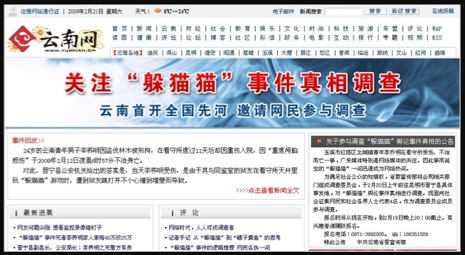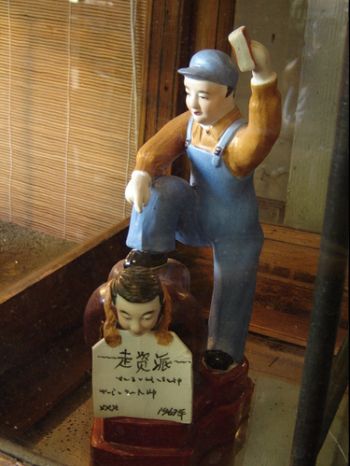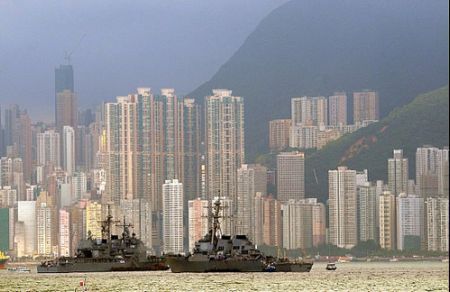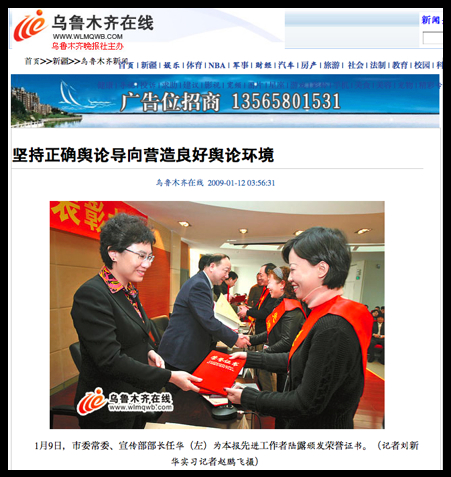How Control 2.0 found its poster boy in Yunnan
By David Bandurski — The so-called “eluding the cat” or “hide-and-seek” incident (躲猫猫事件) continues to take China’s media by storm this week. Those who aren’t yet familiar with the story can find a good round-up at ESWN and a decent summary at Global Voices of skeptical responses from Chinese Web users.
Your options are limited if you’re on the prowl for English-language press coverage of this interesting (and, yes, significant) story. You might try this Shanghai Daily report, or this follow-up story from the official Xinhua News Agency. But foreign press coverage is so far disappointingly credulous.
[ABOVE: February 21, 2009, coverage of the “Duo Mao Mao” case an official Yunnan website. Among the headlines: “In the Web age anyone can be an investigator.”]
The Times reported the story over the weekend, and managed to reach one of the so-called “Internet investigators” involved in the enquiry into the case. But the Times story, with all due respect, seemed to swallow — story hook, line and sinker — the official line from Yunnan propaganda authorities and state media.
The Yunnan case, The Times told us, was “unprecedented”:
Internet users have taken part in an unprecedented investigation brought about by an online uproar after a man died in police custody and an official report blamed his death on a violent game of hide-and-seek . . .
Nevertheless, the entire procedure is a remarkable first for China. Yunnan province has taken some pride in announcing its intention to ensure more transparent government. Gong Fei, Yunnan’s propaganda chief, said: “We’ve invited internet users to investigate the case, and we hope they can made their own judgment and spread the information they see with their own eyes to as many as possible.”
The incident is another example of how Communist Party officials are paying increasing attention to internet discussion, in effect the sole forum in the country with relative freedom of expression.
OK, sure. It is arguably fair, in one sense, to call the actions of Yunnan propaganda authorities “unprecedented.” But we need to be clear about what kind of precedent we’re talking about here. Was this an “unprecedented investigation” or an unprecedented propaganda stunt?
Surely, it must be the latter. Unless, of course, we suppose that propaganda department meddling in criminal investigations sets a viable precedent for greater justice and public participation in China. I’m skeptical. Shouldn’t we all be?
So this is an unprecedented propaganda move, right? Not exactly.
Does anyone remember January 19, 2003? No? Well that day, China’s media told us at the time, was an absolutely historic one for the Internet in China, and for participation in public affairs by ordinary Chinese.
January 19, 2003, was the day that Guo Zhongxiao (呙中校), an ordinary Web user, was granted a face-to-face audience with Shenzhen Mayor Yu Youjun (于幼军) after Guo’s online essay questioning the city’s competitiveness became a hot topic in cyberspace. The essay, “Shenzhen, Who Has Let You Down?”, discussed Shenzhen’s investment environment, state enterprise reforms, administrative efficiency and other issues.
Mayor Yu’s response to Guo’s biting criticisms was a stunt the likes of which had never at the time been seen (it was “unprecedented”). He arranged to meet with Guo, under a blinding media glare of course — a simple matter to arrange when the local media are under your thumb — and they had a “discussion” about Shenzhen’s future. National media quickly picked up the story, and Yu managed to turn online embarrassment into public relations gold.
These days, Yu Youjun’s own future is a far more interesting problem than Shenzhen’s. He was kicked out of the Chinese Communist Party in October last year and now faces corruption charges centering on his business in Shenzhen.
Guo and his essay are at best a distant memory.
The 2003 hype surrounding the Yu-Guo meeting is astonishingly reminiscent of the nonsense surrounding the February 19 decision by propaganda authorities in Yunnan province to include Web users in a special investigative commission.
We were told last Friday that the actions of the Yunnan government were historic: “This is the first time in the history of Internet broadcasting in China that the government has taken such a lofty position, inviting Web users to participate in an investigation,” reported the Yunnan Information Times in coverage re-played across the country. Replace “an investigation” with “policy planning” and it’s déjà vu 2003.
State media are playing this story as a case of popular empowerment. Chinese “netizens” are, we are told, taking the initiative and making real Hu Jintao’s 2007 promise that the party would “guarantee the people’s right to know, participate, express and supervise” (保障人民的知情权、参与权、表达权、监督权).
Admittedly, it’s a great story. The only trouble is, it’s absolute fiction.
The real story here, folks, is very, very simple. It’s not about social and political change. It’s not about the CCP’s pledge to bring greater transparency to government affairs. It’s not (really) about the power of the Internet in China.
It’s all about Wu Hao (伍皓).
That’s right. It’s about an intelligent, 38 year-old former Xinhua News Agency reporter who is rising rapidly through the ranks of China’s propaganda apparatus. It’s about the fresh new face of Chinese propaganda controls in the information age.
Control 2.0 now has its poster boy.
[ABOVE: Yunnan deputy propaganda chief Wu Hao appears in recent coverage of the “Duo Mao Mao” case on a Yunnan-based Website.]
Yunnan’s ingenious approach to “public opinion guidance” in the “eluding the cat” case was masterminded by Wu, who has explained the thinking behind the action in numerous media interviews, like this one that appeared in Southern Metropolis Daily.
“But we didn’t wish to have a repeat of the South China Tiger affair,” Wu Hao told Southern Metropolis Daily in an interview last night. He believes prior experience tells us that the doubts of netizens will not simply evaporate as time passes, but will rise wave upon wave . . .
And there is his classic and revealing line, which we will come back to:
“As for online public opinion, it is best resolved by the laws of the Internet itself.” (“对网络的舆论,要用网络的办法来解决.”)
[ABOVE: February 21 coverage of Yunnan’s response to online criticism of the “eluding the cat” case.]
But who exactly is Wu Hao?
We know from recent news reports that Wu Hao is now deputy propaganda chief of Yunnan province, a post he has held for just two months. Prior to this career move, Wu was a top reporter and editor for the Yunnan provincial branch of Xinhua News Agency. There, among his other accomplishments, he launched and eventually oversaw the top-secret Yunnan Internal Reference (云南内参), a regular compilation of sensitive news reports available only to high-level provincial officials.
We know also that Wu Hao has written a book about his experience as a state journalist, published last year by Xinhua News Agency’s official publishing house. The book is called “Wu Hao Talks About the News” (伍皓说新闻).
A native of Sichuan’s Dazhou City (达洲市), Wu set himself apart at Peking University in the early 1990s as a “distinguished university student representative” (优秀大学生代表). In this capacity, Wu had two separate audiences with then-President Jiang Zemin (江泽民).
Upon graduation with a degree in Chinese Studies in 1992, Wu Hao requested an assignment in Tibet with Xinhua News Agency. He worked as a reporter there for several years before becoming Lhasa bureau chief. In October 1999, Wu was transferred to Xinhua’s Yunnan provincial bureau where he served as head of the political desk. He launched Yunnan Internal Reference in April 2003.
So what do we make of Wu Hao’s first major public move as a propaganda official, which has won him headlines across the country? Is this yet another steady step of progress toward the “sunshine government” Yunnan has been boasting about for at least the last two years?
Of course not. This is an ingenious example of Control 2.0 creative strategizing that is destined to become a propaganda classic.
If you look carefully at the language Wu Hao and others use to talk about this “unprecedented” event, you’ll notice it is not at all about more transparent governance, how to better handle policy or law enforcement issues, or how to ensure greater responsibility and oversight.
Let’s look again at Wu’s now famous line to explain his handling of the “eluding the cat” case:
“As for online public opinion, it is best resolved by the laws of the Internet itself.”
As this sentence should make patently clear, Wu’s objective is not to “resolve” the investigation into the “eluding the cat” case, to make it fairer or more transparent. His objective is to “resolve” the problem of online opinion itself.
In fact, Wu and his office are responding actively to set the agenda in the “eluding the cat” case, exactly what Hu Jintao exorted propaganda officials to do in sections three and four of his important media speech back in June last year. The party, Hu said in that speech, needs to “actively set the agenda” (主动设置议题):
We must perfect our system of news release, and improve our system for news reports on sudden-breaking public events, releasing authoritative information at the earliest moment, raising timeliness, increasing transparency, and firmly grasping the initiative in news propaganda work.
This story is about Wu Hao because he represents, right now, the future of propaganda controls in China. He is a youthful, media savvy, Internet-literate cadre eager to show the CCP bigwigs that he understands the logic of the Internet age and can deliver what Hu Jintao has asked for: a “new pattern of public opinion guidance.”
If we snap out of the fairy tale of Wu Hao’s “Internet investigation”, we realize that progress on real media independence and the independence of China’s court system are the only viable means toward a fair and truthful outcome in cases like this one.
Right now, China is moving backward on both counts. Investigative reporting, in particular, is in a state of rapid decline, and we can suppose there will be no independent investigation by the media of the death of Li Qiaoming.
For the moment, meaningful political reform is off the table in China, and that means any viable form of participation or free expression is inconceivable. But fostering a public perception of self-empowerment and government responsiveness has now become a matter of political urgency for China’s leadership. And that’s what Control 2.0 is all about.
In the government handling of the “eluding the cat” case we can glimpse an eerie phenomenon emerging in China: the rise of virtual political participation as a proxy and foil for real political empowerment. Notice, political rights are not on offer to China’s citizens. But if we believe the hype China’s state media are selling us, China’s “netizens” are in political ascent.
If you believe that, I have a bridge to sell you.
[Posted by David Bandurski, February 24, 2009, 4:24pm HK]





